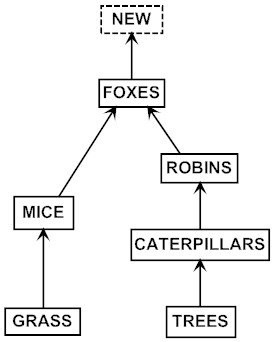Item IE017005: Changes in a population (introduction of a new organism) may affect populations that are not directly connected by a feeding relationship even if they are several steps away in a food web (woodland ecosystem).
The diagram below shows the feeding relationships between populations of plants and animals in an area. The arrows point from the organisms being eaten to the organisms that eat them.

A new species that eats only foxes becomes part of this food web. Using only the relationships between the plants and animals shown in the diagram, which of the following could happen because of this change?
- The amount of grass and the number of mice, robins, caterpillars, and trees could increase.
- The amount of grass and the number of mice, robins, caterpillars, and trees could decrease.
- The number of robins could increase, and the number of caterpillars could decrease.
- The number of robins could decrease, and the number of caterpillars could increase.
Answer Choice |
Overall |
Grades |
Gender |
Primary Language |
||||
|---|---|---|---|---|---|---|---|---|
| n = 1477 |
6–8 n = 859 |
9–12 n = 616 |
Male n = 695 |
Female n = 765 |
English n = 1337 |
Other n = 103 |
||
| A. | The amount of grass and the number of mice, robins, caterpillars, and trees could increase. | 40% | 43% | 37% | 42% | 39% | 40% | 41% |
| B. | The amount of grass and the number of mice, robins, caterpillars, and trees could decrease. | 19% | 20% | 17% | 14% | 23% | 18% | 26% |
| C. | The number of robins could increase, and the number of caterpillars could decrease. | 33% | 29% | 38% | 36% | 29% | 34% | 21% |
| D. | The number of robins could decrease, and the number of caterpillars could increase. | 8% | 8% | 8% | 8% | 8% | 7% | 12% |

